Bottlenose Dolphin Fast Facts
Scientific name: Tursiops truncatus
Class: Mammalia
Average length: 6 to 13 feet
Average weight: 300 to 1,400 pounds
Average lifespan: 40 to 60 years
Cruising speed: up to 22 miles per hour
Gestation period: 12 months
Favorite snack: Headfirst fishsticks
Favorite tunes: Smooth jazz and a little bit of Drake.
Favorite pastime: Tumbling
Bottlenose Dolphins: Dive Deeper
When one thinks of a dolphin, a lively gray-colored animal sporting up tricks, flips, and dips may come to mind. Maybe a famous name such as Flipper flashes across your noggin, and you receive a nostalgic feeling of happiness as you picture a playful and energetic marine mammal splashing about in the sea. This fun and fantastic flipper-wearing friend is referred to as the famous bottlenose dolphin.
Bottlenose dolphins are one of the most well-known species of whales and dolphins. Catching their fame in the limelight of ocean cinema, these dolphins have received much of their popularity from an American television show entitled Flipper. This 1960’s TV program is all about a highly intelligent dolphin who interacts with humans in extraordinary ways. Although well known on the big screen, these dolphins reside all throughout the world in both offshore and coastal waters.
Where do bottlenose dolphins live?
While roaming the open ocean, these beauties can be seen along the West Coast in the United States such as Washington, Oregon, and California as well as in the Aloha Islands of Hawaii.
Along the East Coast, they can be seen from the Yankee’s hometown of New York to the sunny shores of Florida. Other homesteads include the Gulf of Mexico, Caribbean, Mediterranean and Black Seas, the Southwestern Indian Ocean, Australia, Japan, and Chile. They can also touchdown in harbors, bays, estuaries, and gulfs.
Offshore bottlenose dolphins are found in deep waters away from the shore, whereas coastal bottlenose dolphins can be seen from your favorite seat on the beach. As a special treat, both offshore and coastal bottlenose dolphins are spotted in the Dana Point area, leaving both our favorite open ocean voyagers and beach buddies thrilled to catch a glimpse of them.
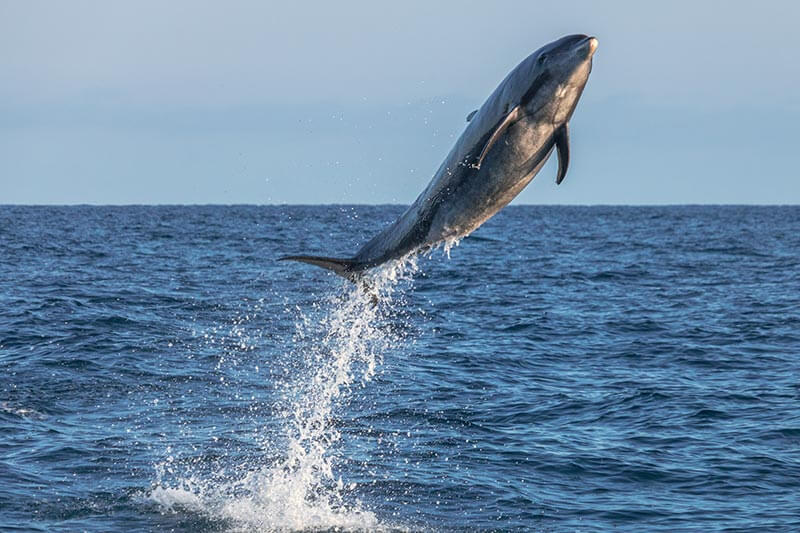
Appearance
Often recognizable by their dorsal fin which sits atop their gray to dark-colored back, they can also be distinguished by their short, thick snout/rostrum. This short and thick snout is what crowned them with their famous name of “bottlenose,” although they are scientifically named the Tursiops truncatus.
The light gray to dark coloring which wraps around their backside is met with a light gray to white color on their belly side. Weighing in at 300 to 1,400 pounds and reaching lengths of 8 to 12 feet, these compadres are one of the larger sized cetaceans in the dolphin arena. Size and coloring vary depending on where these swimmers hang about, as those living in coastal waters are smaller and lighter in color.
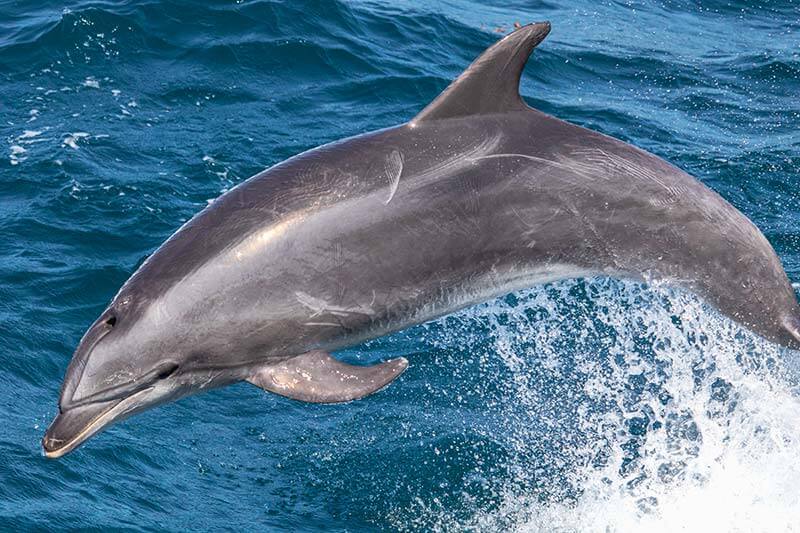
Diet
Both offshore and coastal bottlenose dolphins eat up a diet of mainly fish, squid, and crustaceans, often catching and swallowing them whole. Snatching up their prey both alone or cooperatively, they use unique herding strategies to round up the grub, taking turns charging large schools of fish, or trapping them against seawalls and sandbars for a quick bite to eat. When caught, they grip the fish with their teeth, swallow whole, and make sure to swallow head first to avoid catching the spine of a fish in their throat. Talk about picky eaters…
Cruising the deep blue at speeds of up to 22 miles per hour, they can dive to depths of up to nearly 1,000 feet and hold their breath for up to 8 to 10 minutes. Plummeting to such deep depths and putting their lungs to the test for an extraordinary amount of time has us passing up any breath holding competition with these swim team captains.
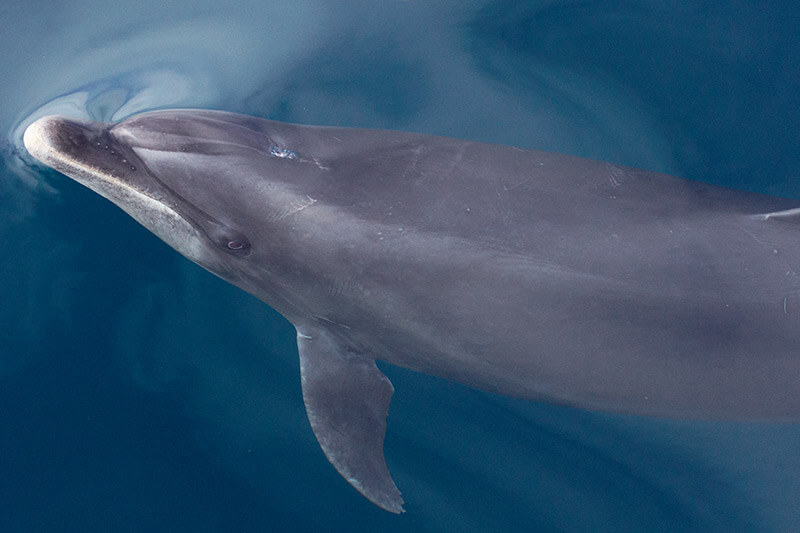
Bottlenose Dolphin Lifespan and Reproduction
When it comes to birthdays, these swimmers love to have them with an average lifespan of up to 60 years for female bottlenose dolphins and 40 years for the gentlemen.
Depending on the population, both genders reach sexual maturity between the ages of 5 and 15 years old. The gestation period for a single calf is up to 12 months. Moms will nurse for 20 months and generally stay with their baby for up to 3 to 6 years. Females can then give birth to another calf every 3 to 6 years, sometimes occurring up until age 45.
Socialization and Communication
When it comes to close-knit family ties within the bottlenose circle of cetaceans, these dolphins are quite independent. Often traveling alone or in social groups that separate and reform, they are unique from other members of the cetacean family, as many other species of dolphins form close-knit ties within pods that last an entire lifetime. When it comes to flying solo, these bottlenose buddies don’t mind. Their independent yet friendly nature has lead scientists to discover that they associate with other dolphins such as pilot whales and Risso’s dolphins. Stranger danger is not a problem with these extroverts.
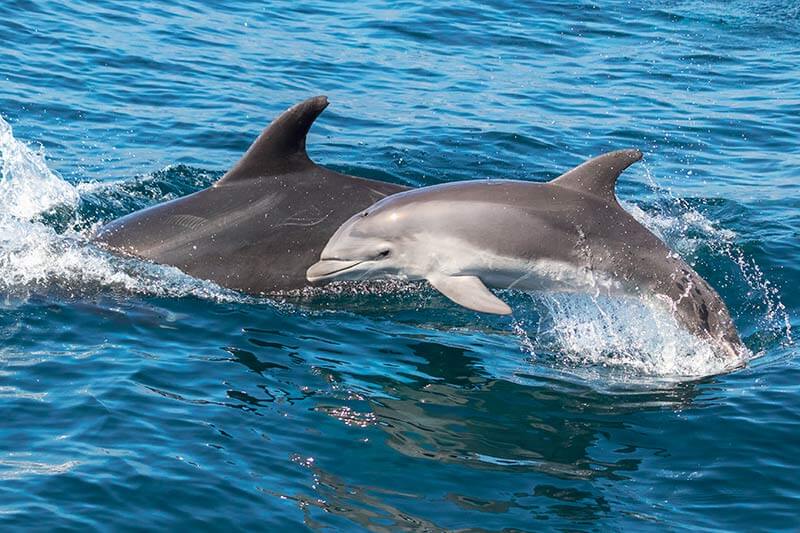
When traveling within a group, they sport-up many ways of interaction such as playing, breeding, aggression, and rubbing. Like our flipper friend, they are a highly social and intelligent mammal, often referred to as one of the smartest living creatures on earth. Using an intricate dialect of squeaks, squawks, and whistles to communicate with other members of their clan, they have been studied to have actual conversations with one another. The study of their speech, as well as their way of living and personality traits, have made them one of the most commonly observed dolphins in the sea. Their quick learning abilities have landed them a spot or two on center stage in many aquariums and parks across the world, as they are great students in the training classroom and put on amazing acrobatic shows.
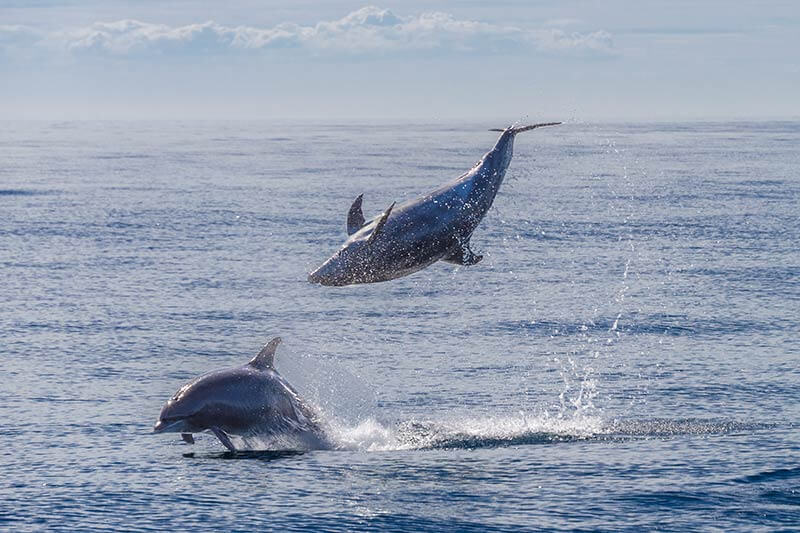
Although teachable and highly intelligent, we prefer to spot these beautiful creatures in the open ocean, where they swim, leap, dive, flip, and put on incredible acrobatic aerial performances to the clapping and cheering of whale watchers. Many elated passengers have even spotted them “bow riding” on the front of giant blue whales!
Threats
Killer whales are a top natural predator of bottlenose dolphins.
With an abundant amount of miles that these dolphins cover, it brings a slew of human activities that threaten their circle of life. Several of these dangers include entanglement in fishing gear, illegal feeding and harassment, habitat degradation, noise, toxins, oil spills, disease, and vessel collisions. These animals are protected by the Marine Mammal Protection Act.
These threats, along with our love for these incredible animals is one of the many reasons why we at Captain Dave’s Dolphin and Whale Watching Safari make sure to provide only eco-friendly whale watching, enabling passengers to view these beauties in safe proximity while sporting up our best ocean steward selves. You won’t be spotting bottlenose dolphins from a fishing boat.
Meet “Patches”
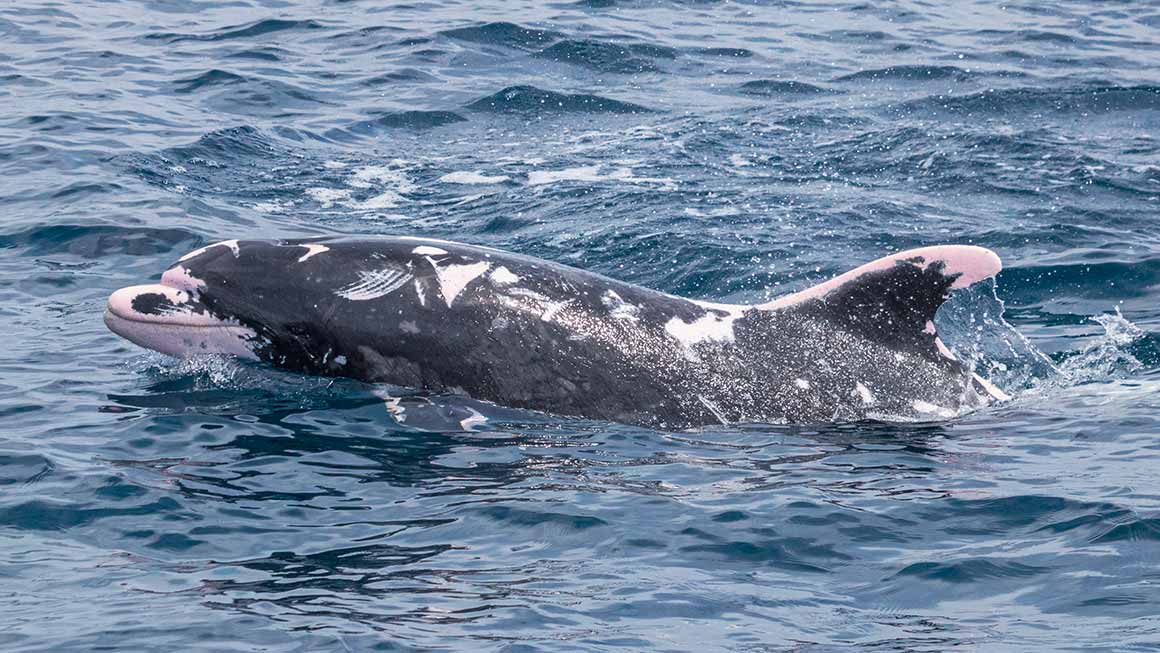
As a special treat, a friendly and locally famous bottlenose dolphin named Patches is a frequent flyer in the SoCal waters. First discovered and named by our staff photographer and naturalist, Mark Tyson, in 2006; this uniquely colored bottlenose is distinguishable by his black, gray, white and pink coloring which sticks out like a gem in our beautiful waters.
Patches’ unique coloring is likely the result of a skin condition called leucism, which is a partial loss of pigmentation.
His pod has been navigating up and down the California coast for many years now, and with all the jovial jumps and playful antics, it’s always our favorite day when they pop by to say hello.
With both eco-types of bottlenose dolphins hanging about in the Dana Point area, it’s always a treat to see what sort of excitement they bring to our day. Both large and small groups of these creatures are seen, comprising of both male and female members along with their adorable calves.
For the opportunity to greet one or many of these cheerful cetaceans, feel free to come aboard one of our daily year-round dolphin and whale watching safari’s where we’ll get you as close as possible with these snazzy swimmers. They can be seen all year round in Dana Point, California, so whether you’re stopping through town on your way to Disney, cruising up or down the coast to your favorite destination, or just looking for something to do on a lazy Saturday afternoon, we’re up and ready to take you on an unforgettable and once in a lifetime adventure.
